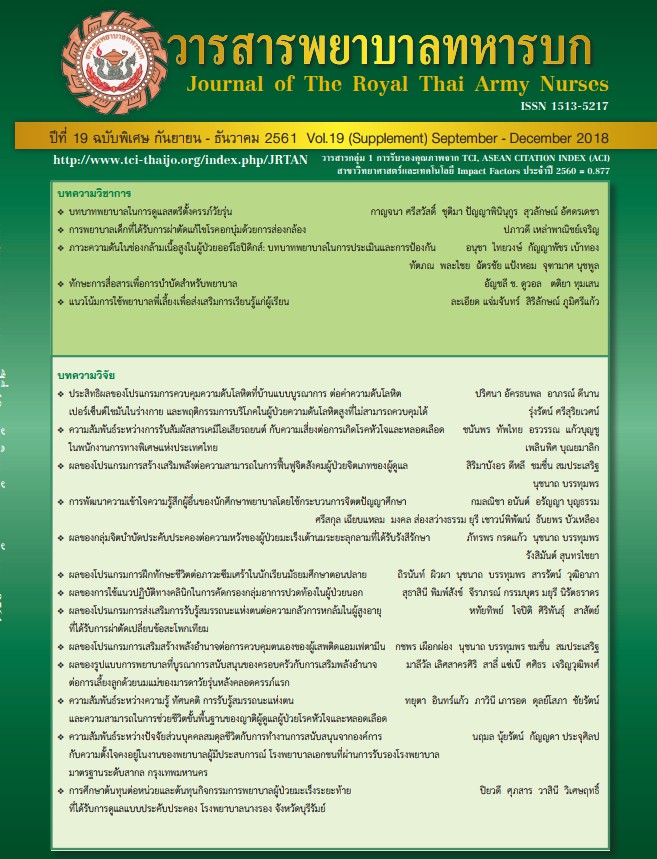Nursing Care of Children Undergoing Minimally Invasive Pectus Excavatum Repair
Keywords:
Pectus Excavatum, Minimally Invasive Pectus Excavatum Repair, Nursing careAbstract
Pectus Excavatum is the most common of the congenital deformities of the sternum. It also affect children when they are adolescent which is affecting the image and mental when to do some activities at school, such as swimming or some sports. In case of severe pectus excavatum, press the heart and lungs affect the circulatory system and respiratory system can be tired and breathlessness due to cardiac pumping has been reduced, the heart valve is not closed and the lungs are not fully expanded. Therefore, it must be improves by operative correction. At present, the treatment is performed by Minimally Invasive Pectus Excavatum Repair (MIPER) or Nuss Procedure. Advantages include shorter operative and less disfiguring scar. The operative nurses are responsible for not only preparing equipment for surgery, but also providing care during preoperative, intraoperative and postoperative care to promote safety and comfort of children. And children live happily.
Downloads
References
2. John L.C. & Andrew M.C. Repair of Pectus Excavatum. Current Surgical Therapy. (11th ed). Philadelphia, PA 19103-2899. 2014; 772-775.
3. Gregory R.D. Alloplastic Reconstruction of Chest Wall Deformities. Reconstructive Surgery of the chest, Abdomen and Pelvis. Marcel Dekker, Inc. All Right Reserved. 2004; 99-111.
4. Laopanitcharoen P.Nursing Care of Children Undergoing Congenital Heart Sugery. Journal of The Royal Thai Army Nurses.2018; 19: 12-21. (In Thai)
5. Phutharangsi S. & Seephom S. Study of the Relationship Between Selected Factors and Perioperative Nurse’s Competencies in Thailand. Journal of Royal Thai Army Nurses.2017; 18(1): 94-103.
6. Sorsuchart S. Deformity of chest wall and lung. Essentials of Thoracic Surgery. (1st ed). Chiang Mai: Jimmy Printshop .Co.th.. 1991; 17-18. (in Thai)
7. Moghissi K.,Thorpe J.A.C.Ciulli (Eds.). Anterior chest wall deformities. Moghissi’s Essentials of Thoracic and Cardiac Surgery. (2nd ed). Elsevier Science B.V. All Right Reserved. 2003; 261-265.
8. Jame C.F., Robert M.F. & Georges L. Pectus Excavatum, Pectus Carinatum and Isolated Defects of the Rib Cage. Pediatric Thoracic Surgery. Elsevier Science Publishing Co; Inc. 1991; 219-229.
9. Choi JH., Park IK., et al. Classification of Pectus Excavatum According to Objective Parameters From Chest Computed Tomography. The Annals of Thoracic Surgery.2016; 102(6): 1886-1891.
10. Janna K.F. Surgical Technology Principles and Practice. (6th ed). Saunders, an imprint of Elsevier Inc. 2013; 960.
11. Paige M.P., Pavan A., Giorgos C.K.,et al. Pulmonary Physiology and Thoracic Disease. The Surgical Review An Integrated Basic and Clinical Science
study Guide 4th.Wolters Kluwer.2016; 348-350.
12. Permpongkosol S., Suvikapagornkul R., et al. Minimally Invasive Repair for Pectus Excavtum. Textbook of Minimally Invasive Surgical Basic and Advanced 1st. Bangkok Medical Journal. 2010; 350-358. (in Thai)
13. Jane C.R. & Sherri M.A. Pediatric Surgery. Alexander’s Surgical Procedures. Mosby, an imprint of Elsevier Inc. 2012; 798.
14. Mark J.C., Donald Nuss, et al. Classification of the dysmorphology of Pectus Excavatum. Journal of Pediatric Surgery.2006; 41: 1573-1581.
15. Binkovitz, Zendeias B., Moir CR., et al. Nuss Bar Migrations: occurrence and classification. Pediatric Radiology. 2016; 46(13): 1797-1803.
16. Kabbaj R., Burrier M., kohler R., et al. Minimally invasive repair of pectus excavatum using the NUSS technique in children and adolescents:
indications, outcomes and limitations. Orthopaedics & Traumatology: Surgery & Research. 2014; 100(6): 625-630.
17. Li B., Zhang J., Guo Y., et al. NUSS procedure by thoracoscopy for minimally invasive correction of pectus excavatum. Zhongguo Xiu Fu Chong
Jian Wai Ke Za Zhi.2013; 27(5): 599-602.
18. Zeng Q., Zhang N., Chen CH., et al. Classification of the pectus Excavatum and minimally invasive NUSS procedure. Zhonghua Wai Ke Za Zhi.2008; 46(15): 1160-2.
19. Park HJ., Jeong JY., Jo WM., et al. Minimally invasive repair of pectus Excavatum: a novel morphology-tailored, patient-specific approach. Journal Thoracic Cardiovascular Surgery.2010; 139(2): 379-86.
20. Chanthawattana B., Tiloksakulchai P., et al. Nursing care for pediatric patients undergoing gastrointestinal surgery. Nursing Pediatric Textbook Volume 2 nd. (1st). Preone limited partnership. 2010; 1095-1113. (in Thai)
21. Siriboonpipattana P. Nursing Pediatric Surgery. Nursing Children 3th. Yuttharin Printing Public Company Limited. 2016; 69-80. (in Thai)
22. James G.O., Andrew W.B., et al. Cardiothoracic Surgery. Principles and Practice of Surgery. (5th ed). Churchill Livingstone Elsevier. 2007; 475.
Downloads
Published
How to Cite
Issue
Section
License
บทความหรือข้อคิดเห็นใดใดที่ปรากฏในวารสารพยาบาลทหารบกเป็นวรรณกรรมของผู้เขียน ซึ่งบรรณาธิการหรือสมาคมพยาบาลทหารบก ไม่จำเป็นต้องเห็นด้วย
บทความที่ได้รับการตีพิมพ์เป็นลิขสิทธิ์ของวารสารพยาบาลทหารบก
The ideas and opinions expressed in the Journal of The Royal Thai Army Nurses are those of the authors and not necessarily those
of the editor or Royal Thai Army Nurses Association.






